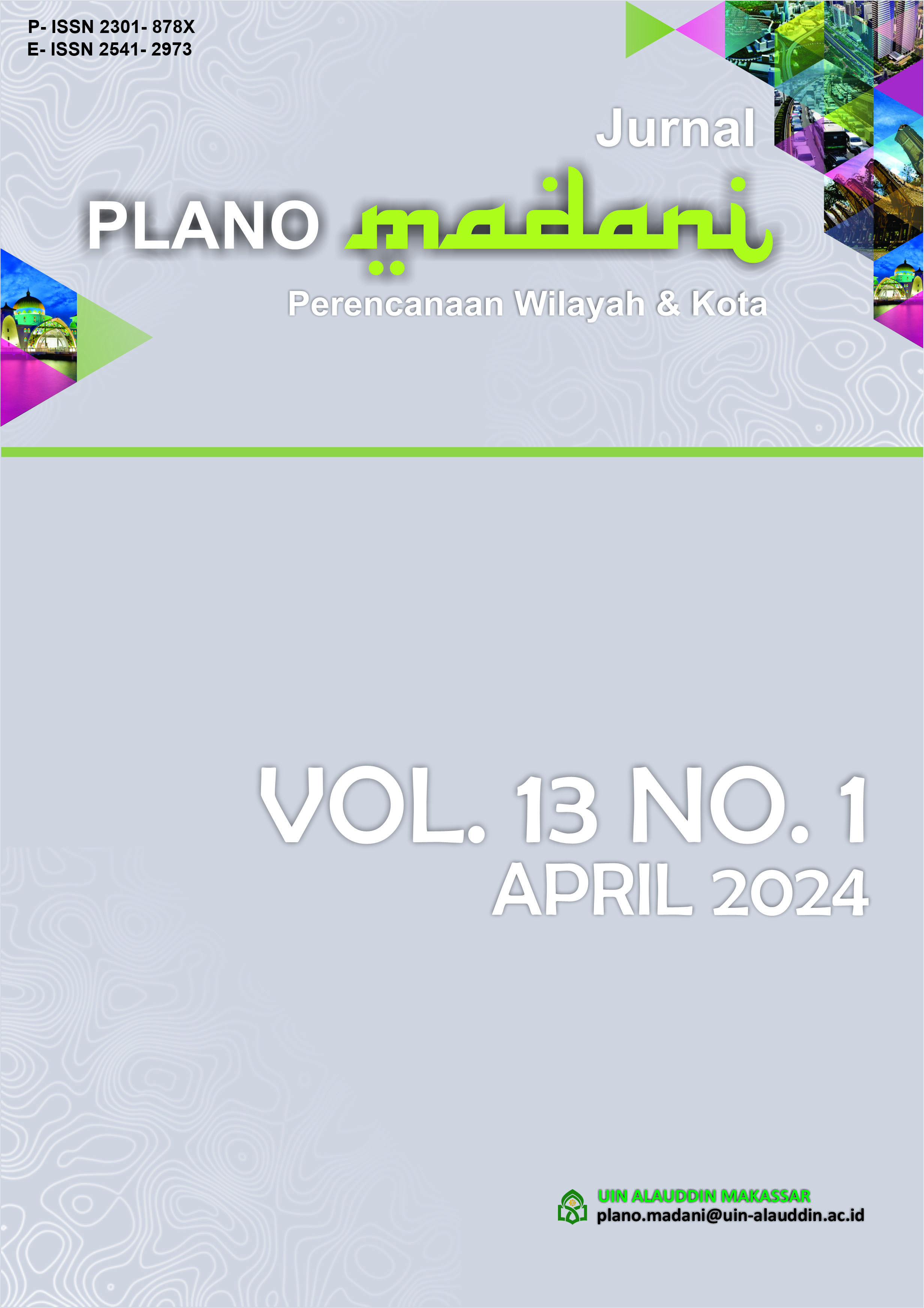ANALYSIS OF SPATIAL PLANNING ALIGNMENT AND STAKEHOLDER PERCEPTIONS TOWARDS THE COASTAL AREA RECONSTRUCTION PLAN IN PALU CITY
Abstract
The Bay of Palu, a central hub for community activities, including tourism, suffered damages and a decline in activities following the 2018 disaster. As of September 2023, the progress of new development is below 10%, and the sluggish reconstruction is influenced by differing stakeholder perceptions. Identifying four stakeholder groups, including local government, the community, traders, and tourists, is the focal point of this research. The aim is to assess the alignment of stakeholder perceptions with spatial allocation guidelines in the reconstruction plan. Using an interpretative paradigm, this study integrates qualitative and quantitative methods through a questionnaire administered to 171 respondents in Palu City. The results indicate a dominance of stakeholder preferences in development expectations, emphasizing the preservation of spatial functions with improved aesthetics. Additionally, the research identifies alignment between stakeholder expectations and spatial allocation guidelines, emphasizing conservation, tourism, and sustainable development.
Downloads
References
Alfiya, N., Winarso, H., & Santoso, D. (2012). Evaluasi Pelaksanaan Kebijakan Pengelolaan Bencana Tsunami di Desa Punge Blang Cut, Kabupaten Aceh Besar. Jurnal Administrasi Publik, 1(2), 93-102.
Ariadi, I. G. (2019). Persepsi stakeholder terhadap arahan pembangunan di provinsi Nusa Tenggara Barat. Jurnal Perencanaan Wilayah dan Kota, 29(2), 117-130.
Harliani, F. (2014). Persepsi Masyarakat Kampung Cieunteung, Kabupaten Bandung tentang Rencanaa Relokasi Akibat Bencana Banjir. Jurnal Perencanaaan Wilayah dan Kota, 25(1), 37-57.
Johnson, R. B., Onwuegbuzie, A. J., & Turner, L. A. (2007). Toward a definition of mixed methods research. Journal of Mixed Methods Research, 1(2), 112-133.
Kasim, A. (2020). Identifikasi kebutuhan masyarakat terdampak bencana sebagai dasar penyusunan rencana rekonstruksi pasca bencana (Studi kasus: Kabupaten Lombok Utara, Nusa Tenggara Barat). Jurnal Teknik Sipil, 22(2), 167-176.
Muttalib, A. (2019). Analisis dampak sosial ekonomi masyarakat pasca bencana gempa bumi di Kabupaten Lombok Utara (KLU). Jurnal Ilmiah Mandala Education, 5(2), 84-91.
Pemerintah Kota Palu. (2023, Juli 20). Kinerja Rekonstruksi Kawasan Teluk Palu. Palu: Pemerintah Kota Palu.
Peraturan Presiden Nomor 8 Tahun 2018 tentang Tata Cara Penyelenggaraan Rekonstruksi Pasca Bencana Gempa Bumi dan/atau Tsunami.
Peraturan Walikota Palu No. 13 Tahun 2023 tentang Rencanaa Kerja Pemerintah Daerah (RKPD) Tahun 2024. Palu: Pemerintah Kota Palu.
Robert, R. (2001). Metode penelitian sosial. Jakarta: PT. Gramedia Pustaka Utama.
Rusdan, M., Nurdin, S., & Irawati, S. (2014). Persepsi masyarakat terhadap rencana penerapan wisata halal di Provinsi Nusa Tenggara Barat. Amwaluna: Jurnal Ekonomi dan Keuangan Syariah, 2(1), 1-12.
Siti, A. (2019). Analisis dampak bencana tsunami terhadap perekonomian Provinsi Sulawesi Tengah. Jurnal Ekonomi Pembangunan, 20(2), 177-194.
Smith, S. R., & Mackie, D. M. (2007). The standardization of the Rosenberg Self-Esteem Scale (RSES) in the Greek population. Social Psychological and Personality Science, 8(6), 546-552.
Sunarto, S., & Marfai, M. A. Skenario Pengelolaan Kepesisiran Berkelanjutan Kabupaten Buton Selatan, Provinsi Sulawesi Tenggara. Ecotrophic, 14(2), 100-110.
Undang-Undang Republik Indonesia. (2017). Undang-Undang Nomor 24 Tahun 2017 tentang Penanggulangan Bencana. Jakarta: Lembaran Negara Republik Indonesia Tahun 2017 Nomor 166, Pasal 1 angka 14.
Copyright (c) 2024 Ibnul Muntaza, Isti Hidayati

This work is licensed under a Creative Commons Attribution-NonCommercial-ShareAlike 4.0 International License.
By Submitting your manuscript to our journal, your are following Copyright & License

